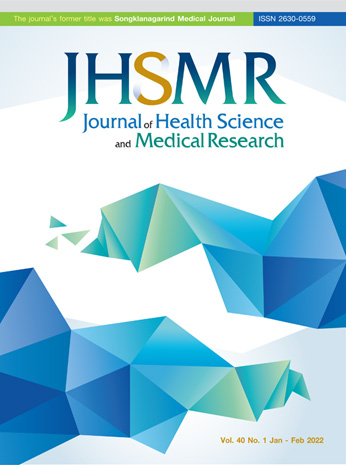Validity and Reliability Measurement of Bengali Translated Questionnaire for Urinary Incontinence Diagnosis
DOI:
https://doi.org/10.31584/jhsmr.2021813Keywords:
QUID, reliability, stress urinary incontinence, urinary incontinence, validityAbstract
Objective: The aim of this study was to translate and verify the validity and reliability of the Bengali translated questionnaire for Urinary Incontinence Diagnosis (QUID), to ensure the diagnosis of urinary incontinence in Bangladesh.
Material and Methods: Adaptation and psychometric properties testing of the Bengali-QUID were conducted with 67 respondents. Twenty respondents were included for pre-testing and adaptation; whereas, 47 respondents were considered for test-retest reliability. The content validity of the questionnaire was measured by expert opinion. Cornbach’s alpha statistical test was used to measure the internal consistency of the questionnaire, while the test-retest reliability was measured using the Intra-Class Correlation (2,1) model.
Results: Content validity for all items of the questionnaire was >0.75. In addition, the Cronbach's Alpha values for interitem correlation for Stress Urinary Incontinence and Urge Urinary Incontinence were (α>0.8) and (α>0.7), respectively. Furthermore, the reliability of the Bengali-QUID questionnaire had an Intra-class correlation score of 0.76.
Conclusion: This study demonstrated that the Bengali version of QUID questionnaire was highly valid, and reliable for diagnosis of urinary incontinence among Bangladeshi women.
References
Milsom I. The prevalence of urinary incontinence. Acta Obstet Gynecol Scand 2000;79:1056-9.
Irwin DE, Kopp ZS, Agatep B, Milsom I, Abrams P. Worldwide prevalence estimates of lower urinary tract symptoms, overactive bladder, urinary incontinence and bladder outlet obstruction. BJU Int 2011;108:1132-8.
Bradley CS, Rovner ES, Morgan MA, Berlin M, Novi JM, Shea JA, Arya LA. A new questionnaire for urinary incontinence diagnosis in women: development and testing. American J Obst Gynecol 2005;192:66-73.
Bradley CS, Rahn DD, Nygaard IE, Barber MD, Nager CW, Kenton KS, Siddiqui NY, Abel RB, Spino C, Richter HE. The questionnaire for urinary incontinence diagnosis (QUID): validity and responsiveness to change in women undergoing nonsurgical therapies for treatment of stress predominant urinary incontinence. Neurourol Urodyn 2010;29:727-34.
Coe R. It’s the effect size, stupid. British Educ Res Assoc Annual Conf 2002;12:14.
Varni JW. Linguistic validation of the PedsQLTM-A quality of life questionnaire [homepage on Internet]. Lyon: Mapi Research Institute; 2002 [cited 2012 Jun]. Available from: http://www.pedsql.org/translations.html
Irwin DL, Lass NJ, Pannbacker M, Koay ME, Whited JS. Clinical research methods in speech-language pathology and audiology. 3rd ed. San Diego, CA: Plural Publishing; 2019.
Lyubomirsky S, Lepper HS. A measure of subjective happiness: Preliminary reliability and construct validation. Soc Indic Res 1999;46:137-55.
Lukitasari M, Hasan R, Handika J, Primiani C, Pujiati P, Dewi NK, Widiyanto W, Murtafiah W. Content validity study: instrument development to measure professional learning communities through lesson study. Int Conf Math Scie Educ 2018;3:75-8.
Dhillon HK, Zaini MZ, Quek KF, Singh HJ, Kaur G, Rusli BN. Exploratory and confirmatory factor analyses for testing validity and reliability of the malay language questionnaire for urinary incontinence diagnosis (QUID). Open J Prevent Med 2014;4:844.
Botlero R, Davis SR, Urquhart DM, Shortreed S, Bell RJ. Agespecific prevalence of, and factors associated with, different types of urinary incontinence in community-dwelling Australian women assessed with a validated questionnaire. Maturitas 2009;62:134-9.
SasivimolS, ChailertPh. Validation of the questionnaire for urinary incontinence diagnosis-Thai version [QUID-Thai version]. J Med Assoc Thai 2018;101:1251-4.
Li CY, Zhu L, Lang JH, Xu T, Shi XW. Exploratory and confirmatory factor analyses for testing validity and reliability of the Chinese language questionnaire for urinary incontinence diagnosis. Zhonghuafu Chan Kezazhi 2016;51: 357-60.
de Araujo CC, Juliato CR, de Andrade Marques A, Reis A, Brito LG. Validation and cultural translation for the Brazilian Portuguese version of the Questionnaire for Urinary Incontinence Diagnosis. Int Urogynecol J 2020;1:1-6.
Downloads
Published
How to Cite
Issue
Section
License

This work is licensed under a Creative Commons Attribution-NonCommercial-NoDerivatives 4.0 International License.
























